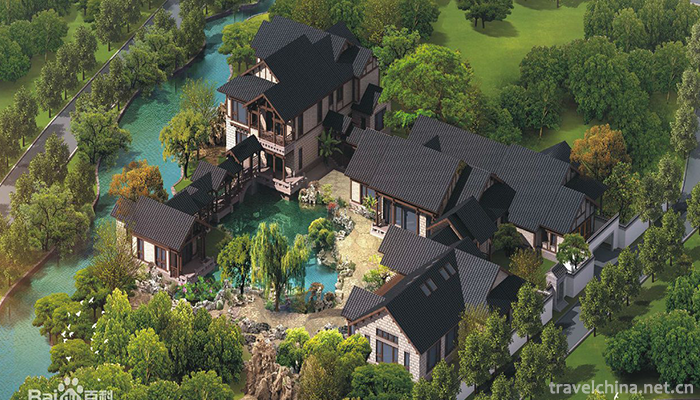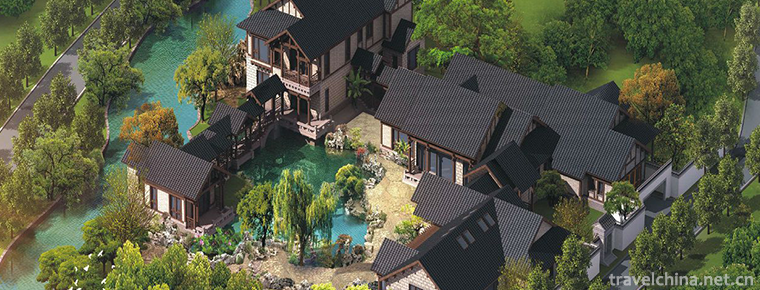Huanshui Bay Hot Spring Resort
Huanshui Bay Hot Spring Resort
Huanshui Bay Hot Spring Tourist Area of Anyang City is located at the exit of Anlin Expressway in Anyang Hi-tech Development Zone, Henan Province, close to National Highway 107 and the west side of Beijing-Guangzhou Railway. It covers an area of more than 1000 mu and is the key project of the development of ecological tourism in Anyang City. It is also the largest comprehensive hot spring scenic spot with the highest scale, the highest grade and the most complete service in Anyang City.
geographical environment
The planning supporting projects of Huanshui Bay Hot Spring Tourist Area include hotels, hot springs, restaurants, conference centers, landscape parks, museums, oceanic halls, recreational and recreational areas, villas and so on. The tourist area has rich and precious deep hot mineral water collected from more than 1600 meters underground, and meets the national drinking water standard. It is rich in trace elements and minerals such as fluorine, strontium, lithium, iron, metasilicic acid, bromine, iodine and other beneficial human beings. It relies on this precious and abundant hot spring water resources, as well as large luxuriant flower and fruit forests (58 kinds of precious flower and tree parks) in the tourist area. The exquisite Suzhou gardens, elegant and generous architectural style, the leisure features of the hot springs shared by men and women, and the Garden Hot Springs area which accommodates thousands of people, have formed the unique high-grade natural hot springs tourist area in Anyang City, and become the trump card and new bright spot of Anyang City's tourism.
Hot spring water quality
The deep and high quality hot mineral water, collected from more than 1600 meters underground, meets the national drinking water standard and is rich in trace elements and minerals such as fluorine, strontium, lithium, iron, metasilicic acid, bromine, iodine and so on.
Main attractions
Nanyuan covers an area of about 3000 square meters and its building area is 168 square meters. Located in the south of the ecological park, the main entrance enters from the east, which is called purple gas coming from the east. In the design, the building is generally a enclosed courtyard, which is opened only in the south. The indoor function of the building is closely intertwined with the theme of the outdoor garden. Through two corridors, the building function is divided into three parts: public activity area (conference, dining room and swimming SPA), private sleeping area and quiet water study. In the same place, the South Garden is also divided into three parts - the main water garden in the middle and four in the north. The theme parks in series are separated by wall subdivisions. This so-called "garden must be separated, water must be melodied".
The main living room and lounge are facing the large water surface and the shallow mountainous area to the south. They belong to the typical three-section garden layout in the south of the Yangtze River - architecture, mountains and waters. Architecture and landscape infiltration, water Rao architecture, building water, make the tortuous water surface endless, make people daydream about the source of water and the far-reaching space, fully show the water-centered spirit of Suzhou gardens.
Beiyuan covers an area of about 3300 square meters, and its building area is 1227 square meters. Located in the north of the park, the main entrance is from the south, planting magnolia, crabapple and peony, metaphorical "Yutang rich and noble". The Ministry of Architecture is a half-enclosed courtyard, which opens to the west. At the same time, there is a dark fragrant and sparse cinema in the northeast corner of the case. It connects the restaurant and chess room. It can cook wine and enjoy plums outdoors. The main water park is thin in the East and the west, and the terrain is like Jichang Garden. A Pavilion in the water becomes the visual focus of the whole main park. At the same time, it is also a good place for residents to stay and enjoy the scenery.
The whole layout is divided into indoor swimming pool SPA area, visitor recreation area, dining area and sleeping area from south to north. The buildings are connected by water corridors, the garden is connected by overlapping water from north to south, the stone bridge is built on the east, and a study or piano room is built in the Northeast corner. There are cave days. The most delicate spots are plum fragrance in winter and lotus fragrance in summer, which can be used for the exchange of scholar and ink visitors. "
Tourism information
Traffic information
Self driving route
Zhengzhou-Anyang: Beijing-Hong Kong-Macao Expressway Anyang South Exit Yangtze River Avenue (top left turn 500 meters) Zhangde Road (Luxi)
Xinxiang-Anyang: Beijing-Hong Kong-Macao Expressway Yangtze River Avenue Changde Road Luxi
Hebi-Anyang: Beijing-Hong Kong-Macao Expressway Yangtze River Avenue (top left turn 500 meters) Changde Road (Luxi)
Handan-Anyang: Beijing-Hong Kong-Macao Expressway Yangtze River Avenue (left turn) Changde Road (south)
Puyang-Anyang: Daguang Expressway Nanlin Expressway Anyang Kou North Changde Road (with road signs)
Under the south exit of Anyang, the Xiajing-Hong Kong-Macao Expressway goes west along the Yangtze River Avenue and turns south (Changde Road) 500 meters west.
Under the North Pass of Anyang: The XiaJing-Hong Kong-Macao Expressway follows the People's Avenue westward, turns southward to Zhangde Road, and crosses the Yangtze River Avenue to 500m southward to the west.
Export of Anlin High Speed Development Zone to North 1.2KM Road West


-
1.Chongqing small noodles
Chongqing small noodles is one of the four characteristics of Chongqing
Time 2018-10-12 -
2.Zhouzhuang Town
Zhouzhuang Ancient Town is a preferred site for world cultural heritage and the first batch of national 5A tourist attractions. It is located in the southeast of Suzhou City and at the junction of Kun
Time 2018-12-06 -
3.Jianmenguan Scenic Area
Jianmenguan Scenic Area is one of the national AAAAA class tourist attractions, National Scenic spots, national key cultural relics protection units, National Forest park, national natural and cultura
Time 2018-12-12 -
4.The Huaming Tower Scenic Area
Huaming Tower Tourist Area: National AAAAA Tourist Area, National Key Cultural Relics Protection Unit, National Patriotic Education Base.
Time 2018-12-12 -
5.Sansu Temple Scenic Area
Sansu Temple Scenic Area is located in the west of Meishan City, Sichuan Province. It is a national AAAA-level tourist attraction, a national key cultural relics protection unit, and a national second
Time 2018-12-19 -
6.Huashan pictographs
Huashan rock paintings are located in the Zuojiang River and its tributary Mingjiang River valley of Chongzuo City, Guangxi (covering Ningming County, Longzhou County, Jiangzhou District and Fusui Cou
Time 2019-01-17 -
7.Lianhuashan Ski Resort
Located in Zhangzhen, Shunyi District, Beijing, Lianhuashan Skiing Ground covers an area of more than 1 million square meters and was opened on December 19, 2003.
Time 2019-01-29 -
8.Han tune
The mast of Hanzhong Diaoqu, a local traditional drama in Hanzhong City, Shaanxi Province, is one of the national intangible cultural heritages.
Time 2019-05-02 -
9.Wool Textile and Rolling Techniques
Flower felt is the most popular among all ethnic handicrafts in Xinjiang, and it has a long history. Felt caps from the 1st to 3rd centuries A.D. are among the cultural relics unearthed at Lop Nur Lou
Time 2019-05-25 -
10.Sachet
Incense bag is also called odor-tolerant, incense bag, incense bag, incense sauce, Pei Mo. Nowadays people call it purse, toy and dim. It is a folk embroidery handicraft created by ancient Chinese wor
Time 2019-07-03 -
11.cheongsam in the Republic of China
Since 1840, the western culture has been infiltrated into the local culture of the Qing Dynasty. Many coastal cities, especially Shanghai, have taken the lead in western culture because of the mixture of Chinese and foreign cultures, and their clothing has begun to undergo potential changes.
Time 2020-12-11 -
12.Administrative division of Mianyang
Mianyang City has jurisdiction over 9 county-level administrative divisions (Municipal District 3, county-level city 1, county-5), 166 township level administrative divisions (street 13, town 122, township 31), and manages the Science City Office of Sichuan
Time 2020-12-14